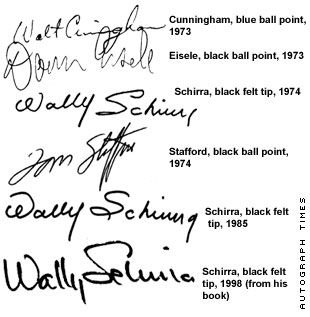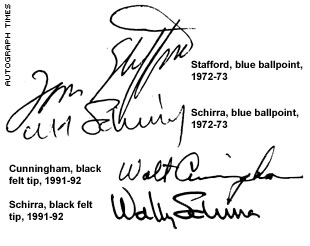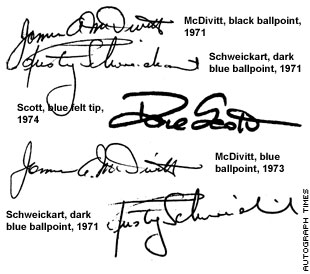|
The following article first appeared in the April 2000 issue of Autograph Times. It is reprinted here with permission.
Building an Apollo collection
by Dr. William R. Hanson
As we prepare to enter the new millennium (on 1 January 2001), many collectors are looking to build collections on the significant events of the 20th century, and the men and women who shaped them.
The first tentative steps of humanity into a truly alien environment (space) and our first in-person exploration of another celestial body (our moon) has become an increasingly popular area of autograph collecting, in the persons of our Apollo Astronauts. While most people can tell you who first stepped onto the lunar surface, can you name the last man to step onto the moon, or the first to fly the Lunar Excursion Module (LEM or LM) in space?
When I started collecting astronaut signatures upon my return from Vietnam in 1969, you wrote to the astronauts at their office at Johnson Space Center (JSC), or their home if you were lucky enough to have located a home address. You got back two or three genuine or autopen signatures on the items you'd submitted, or on NASA-supplied lithographs. Either way, it cost you virtually nothing.
Whether you got the real thing or an machine signature -- or a secretarial in the case of Alan Shepard -- depended mostly on what the man was doing the day a pile of mail reached his office.

Practically everyone was signing, and you were as likely to get a genuine signature from Neil, Buzz or Mike as you were from an unflown like Ron Evans or Jack Schmitt. And getting an item signed by a complete crew was often as easy as asking Jim Irwin, or Charlie Duke or Stu Roosa to ask their crewmates to sign also.
In those days, astronauts didn't charge for their signature. They simply signed or didn't. There were no dealer contracts, exclusive or otherwise, no one except Neil Armstrong objected to signing philatelic items, and there were no little astronaut-family cottage industries marketing signatures.
Professional autograph dealers didn't fool with astronaut autographs as there was little demand (why pay for what you could get for nothing?) and prices were low. In fact, most sales were at modest prices by space cover dealers and collectors who got the photographs as a sideline to cover collecting.
Today, things have changed. Virtually all the Mercury, Gemini and Apollo astronauts have retired from government service, and sadly quite a few have passed on.
I could go on for pages regaling you how I got this autograph or that, or this piece of flown on this moon landing or that. But you can't move the clock back 30 years, and you aren't likely to meet many moonwalkers in the halls of the JSC or Kennedy Space Center these days as I did back then, so I'll try to cover Apollo astronaut signature collecting as it is now, and give you some guidance on what you might reasonably expect to acquire starting from scratch.

(Note: The signature examples shown are genuine, dates are approximate year signed.)
Prior to the first moon landing all the spacecraft, equipment for the landings and the various techniques of rendezvous and docking, navigation, etc. had to be proven in the harsh environment of space. So, NASA flew Apollos 7 and 9 in earth orbit, and Apollos 8 and 10 in Lunar orbit. Apollo 13, while intended as the third manned lunar landing suffered an explosion in space and was turned into a harrowing circumlunar flight, and the astronauts returned safely by the skin of their teeth.
Apollo 7, under the command of Mercury and Gemini astronaut Walter A. "Wally" Schirra, was intended to wring out the Apollo Command Module in earth orbit. Wally's crewmates, who also shared his cold or flu, were Walter Cunningham and the late Donn Eisle. Schirra's signature varies widely, and whether he uses a ballpoint, or felt tip makes quite a difference. (I show several genuine examples with years signed.)
In his many years as a space commentator with CBS, and even later, his signing habits varied greatly. For a while he'd sign everything, then for a long while he'd return everything unsigned, then he'd start up again. Currently, he has a contract with a private company which must be quite strict as I don't know of anyone who has had success in recent years writing direct.
Nevertheless, I include his address in case you want to try. I haven't personally sent a copy of his "Schirra's Space," so don't know if that might be an exception to the rule. Most astronauts are pretty good about signing their books.
Walt Cunningham, whose signature hasn't changed much through the years, also has commercial ties, but does sign from the address I've listed. Recently, he raised his fee to $30 per signature. For years he freely sent out signed NASA lithos for a SASE, so I'd imagine if you asked him nicely to add something like Apollo 7, or the dates of the flight, or to personalize that he would comply. He was always nice to space collectors.
The late Donn Eisle was also good to collectors, but he passed away many years ago and the supply of his autographs is not great.
Apollo 9 was the first test of the Lunar Lander (LEM) in space. Gemini IV veteran James A. McDivitt was again in command and was the first man to pilot the LEM in space. Rookie Rusty Schweickart was the Lunar Module Pilot and made the first Extravehicular Activity (EVA) -- in other words he got out the door of the LEM wearing a moon-walker suit. Gemini veteran Dave Scott was Command Module Pilot and flew the first rendezvous and docking of the Apollo Program.
Gen. McDivitt has always been most kind to collectors. He will sign one or two items per person without charge, including covers. He does not add inscriptions such as titles or mission numbers, but I'm sure he would personalize if desired. A real gentleman, and deserving of collectors' thanks for more than 35 years of generosity.

Rusty Schweickart was always kind to collectors, but in recent years seems to have sought seclusion and no longer responds to collector requests. I include the best address I have nonetheless. He was generous in the past, so there are a lot of his signatures out there. Since demand is not great, price should be reasonable unless you insist on a specific item, and that it not be personalized to someone else.
Dave Scott was one of the shining stars of the Astronaut Corps: handsome, outgoing, on the fast track to a general's stars. Then he got mixed up in that crazy business of carrying hundreds and hundreds and hundreds of covers to the moon for some German dealer, and that was it. They shipped him off to command at Edwards until his retirement came up.
Except when he was at Edwards, Scott was always a hard autograph to get. Jim Irwin helped me get signatures a couple of times, and even that of Neil Armstrong, his Gemini VIII crewmate. Scott's tiny, precise signature has changed virtually not at all, which makes his autopens all the more dangerous. (I show a couple of genuine examples.)
In my experience, requests sent to Scott's business address are kept, but not responded to, so be warned if you try a mailing. And for goodness sakes, send a photo not a philatelic cover! DestinySpace seems to be the only dealer offering signed photographs at the moment and they are expensive. [Note: In the time since this article was published, Scott has partnered with NovaSpace Galleries.]
Photographs for signing
While the Astronaut Office at JSC in Houston still sends out color 8x10 lithographs for free, you basically have to take what they feel like giving you on a given day.
I have located one relatively inexpensive source for true photographic prints, Jeremy Theoret of ApolloSpace. A collector himself, Theoret has selected his stock with an eye for autographing possibilities. His price of $7.00 per color 8x10 is reasonable, selection is good and growing and service is quick. You can visit his web site at Apollospace.com. For his printed catalog, send 77 cents in postage to: ApolloSpace, 2503 Valencia Dr. NE, Albuquerque, NM 87110-4014.
| 


